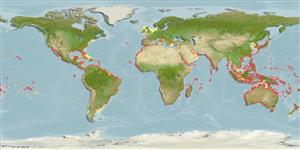Hypnea valentiae (Turner) Montagne
| Native range | All suitable habitat | Point map | Year 2050 |

|
| This map was computer-generated and has not yet been reviewed. |
| Hypnea valentiae AquaMaps Data sources: GBIF OBIS |
Google image |
No photo available for this species.
Classification / Names Common names | Synonyms | CoL | ITIS | WoRMS
Florideophyceae | Gigartinales | Hypneaceae
Environment: milieu / climate zone / depth range / distribution range Ecology
Sessile; depth range 0 - 33 m (Ref. 102653). Tropical
Distribution Countries | FAO areas | Ecosystems | Occurrences | Introductions
Atlantic Ocean: from North Carolina, USA, to the Caribbean, south to Brazil, east to Herault, France, including Bermuda, Salvage Islands and the Mediterranean; in the Canary Islands, south to São Tomé and Príncipe, including Cape Verde Islands. Indian Ocean: from the Arabian Sea south to Madagascar, including the Red Sea, Persian Gulf, Oman Sea, Aldabra Islands, Seychelles, Reunion and Mauritius, east to India and south to the Andaman Sea; in Australia, from Western Australia to Victoria. Pacific Ocean: in the Philippines, Viet Nam, Federated States of Micronesia and Fiji, east to California including the Hawaiian Islands, and south to Peru.
Length at first maturity / Size / Weight / Age
Maturity: Lm ? range ? - ? cm
Life cycle and mating behavior Maturity | Reproduction | Spawning | Eggs | Fecundity | Larvae
Main reference
References | Coordinator | Collaborators
Guiry, M.D. and G.M. Guiry. 2009. (Ref. 80701)
IUCN Red List Status
(Ref. 130435: Version 2024-2)
CITES status (Ref. 108899)
CMS (Ref. 116361)
Threat to humans
Human uses
| FishSource |
Tools
More information
Diet composition
Food consumption
Predators
Max. ages / sizes
Length-weight rel.
Length-length rel.
Length-frequencies
Mass conversion
Abundance
Internet sources
BHL | BOLD Systems | CISTI | DiscoverLife | FAO(Publication : search) | Fishipedia | GenBank (genome, nucleotide) | GloBI | Gomexsi | Google Books | Google Scholar | Google | PubMed | AlgaeBase | Tree of Life | Wikipedia (Go, Search) | Zoological Record


